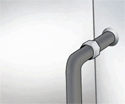Molds can be found almost anywhere; they can grow on virtually any organic substance, as long as moisture and oxygen are present. There are molds that can grow on wood, paper, carpet, foods, and insulation. When excessive moisture accumulates in buildings or on building materials, mold growth will often occur, particularly if the moisture problem remains undiscovered or unaddressed. It is impossible to eliminate all mold and mold spores in the indoor environment. However, mold growth can be controlled indoors by controlling moisture indoors.
The Key to Mold Control is Moisture Control.
It is important to dry water damaged areas and items within 24-48 hours to prevent mold growth. If mold is a problem in your home, clean up the mold and get rid of the excess water or moisture. Fix leaky plumbing or other sources of water. Wash mold off hard surfaces with detergent and water, and dry completely. Absorbent materials (such as ceiling tiles & carpet) that become moldy may have to be replaced.
Have a question about mold and mold cleanup. Scan our mold-related Frequently Asked Questions [en español]
- IAQ Tools for Schools Action Kit - IAQ Reference Guide - Appendix H: Mold and Moisture
- Indoor Air Quality Building Education and Assessment Model (I-BEAM) Text Modules: Fundamentals of IAQ in Buildings
- Building Air Quality: A Guide for Building Owners and Facility Managers - Appendix C: Moisture, Mold and Mildew

Publications and Resources
Read "A Brief Guide to Mold, Moisture, and Your Home" (también disponible en español como un archivo en formata PDF (PDF, 20 pp, 1.17MB)). If you are a building manager, custodian, or other person responsible for commercial buildings and school maintenance, read "Mold Remediation in Schools and Commercial Buildings". (This guidance also applies to residences.)
Mold Course

If you are an environmental and/or public health professional, take the Mold Course - Introduction to Mold and Mold Remediation for Environmental and Public Health Professionals.
This web-only course contains information on mold prevention and remediation. It is designed primarily for environmental and public health professionals. The Mold Course has nine chapters; these chapters are further divided into smaller lessons. At the end of each chapter there is a voluntary quiz to test your understanding of the material covered. Each chapter may be accessed at any point in the course using the menu on the left side of the page. If you would like to take a short quiz on your current mold knowledge, begin with the Pre-Test. A Mold Image Library contains mold-related images in seven categories: mold in the environment; magnified mold; moisture and moisture damage; prevention; mold in buildings; finding mold and moisture; and cleaning and remediation. These photos may be used for presentations and educational purposes without contacting EPA.
Additional Guidance
For basic information and resources on mold, go to our Mold Resources page
Read the Guidance for Health Professionals - Guidance for Clinicians on the Recognition and Management of Health Effects Related to Mold Exposure and Moisture Indoors (September 30, 2004), published by the Center for Indoor Environments and Health at University of Connecticut Health Center with support from a grant by the U.S. EPA.
- For more information, see http://oehc.uchc.edu/clinser/indoor.htm
This 120 page document is also available in PDF format from their site http://oehc.uchc.edu/clinser/MOLD GUIDE.pdf
![[logo] US EPA](https://webarchive.library.unt.edu/eot2008/20090107011249im_/http://www.epa.gov/epafiles/images/logo_epaseal.gif)